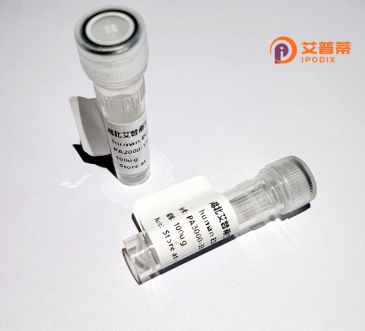
| 纯度 | >90%SDS-PAGE. |
| 种属 | Human |
| 靶点 | EPAS1 |
| Uniprot No | Q99814 |
| 内毒素 | < 0.01EU/μg |
| 表达宿主 | E.coli |
| 表达区间 | 28-347aa |
| 活性数据 | SKETEVFYELAHELPLPHSVSSHLDKASIMRLAISFLRTHKLLSSVCSENESEAEADQQMDNLYLKALEGFIAVVTQDGDMIFLSENISKFMGLTQVELTGHSIFDFTHPCDHEEIRENLSLKNGSGFGKKSKDMSTERDFFMRMKCTVTNRGRTVNLKSATWKVLHCTGQVKVYNNCPPHNSLCGYKEPLLSCLIIMCEPIQHPSHMDIPLDSKTFLSRHSMDMKFTYCDDRITELIGYHPEELLGRSAYEFYHALDSENMTKSHQNLCTKGQVVSGQYRMLAKHGGYVWLETQGTVIYNPRNLQPQCIMCVNYVLSEI |
| 分子量 | 60.83 kDa |
| 蛋白标签 | GST-tag at N-terminal |
| 缓冲液 | PBS, pH7.4, containing 0.01% SKL, 1mM DTT, 5% Trehalose and Proclin300. |
| 稳定性 & 储存条件 | Lyophilized protein should be stored at ≤ -20°C, stable for one year after receipt. Reconstituted protein solution can be stored at 2-8°C for 2-7 days. Aliquots of reconstituted samples are stable at ≤ -20°C for 3 months. |
| 复溶 | Always centrifuge tubes before opening.Do not mix by vortex or pipetting. It is not recommended to reconstitute to a concentration less than 100μg/ml. Dissolve the lyophilized protein in distilled water. Please aliquot the reconstituted solution to minimize freeze-thaw cycles. |
1. **文献名称**:Structural Basis for Hypoxia Regulation by the Human EPAS1 Protein
**作者**:Wu D, et al.
**摘要**:该研究通过X射线晶体学解析了重组人EPAS1(HIF-2α)与ARNT蛋白的复合物结构,揭示了其氧敏感结构域如何感知低氧环境并调控靶基因表达的分子机制。
2. **文献名称**:EPAS1 Promotes Tumor Progression via Hypoxia-Independent Metabolic Reprogramming
**作者**:Rankin EB, et al.
**摘要**:研究利用重组EPAS1蛋白进行功能实验,发现其在低氧条件下促进肿瘤细胞糖酵解及脂质合成的功能,并揭示其通过非低氧依赖途径驱动肿瘤代谢重塑的机制。
3. **文献名称**:A Small Molecule Inhibitor of HIF-2α (EPAS1) for the Treatment of Renal Cell Carcinoma
**作者**:Chen W, et al.
**摘要**:文章报道了一种靶向重组EPAS1蛋白的小分子抑制剂,通过阻断HIF-2α-ARNT复合物形成抑制肾癌细胞增殖和血管生成,为临床治疗提供了新策略。
4. **文献名称**:EPAS1 Mutations Disrupt Protein Stability and HIF Signaling in Hereditary Erythrocytosis
**作者**:Percy MJ, et al.
**摘要**:研究分析了EPAS1基因突变对重组蛋白稳定性的影响,揭示了突变导致HIF-2α异常积累并引发遗传性红细胞增多症的病理机制。
Recombinant human EPAS1 protein, also known as hypoxia-inducible factor-2α (HIF-2α), is a key transcriptional regulator involved in cellular responses to low oxygen levels. EPAS1 belongs to the hypoxia-inducible factor family and shares structural homology with HIF-1α, though it exhibits distinct target gene specificity and regulatory roles. Under normoxic conditions, EPAS1 is rapidly degraded via the ubiquitin-proteasome pathway, mediated by oxygen-dependent prolyl hydroxylation. During hypoxia, it stabilizes and dimerizes with HIF-1β (ARNT) to activate genes critical for angiogenesis, erythropoiesis, metabolism, and tumor progression.
Recombinant EPAS1 is typically produced using expression systems like *E. coli* or mammalian cells, enabling research into its molecular mechanisms and interactions. It plays a dual role in physiology and disease: while essential for adaptation to hypoxia, its dysregulation is implicated in cancers (e.g., renal cell carcinoma), pulmonary hypertension, and ischemic disorders. Studies focus on its tissue-specific functions, such as iron metabolism in the liver or catecholamine synthesis in the adrenal medulla. Recombinant EPAS1 proteins are vital tools for exploring oxygen-sensing pathways, developing HIF-2α-targeted therapeutics, and elucidating its crosstalk with other signaling networks like mTOR or ROS pathways. Its therapeutic modulation holds promise but requires careful balancing of oncogenic risks and cytoprotective benefits.
×